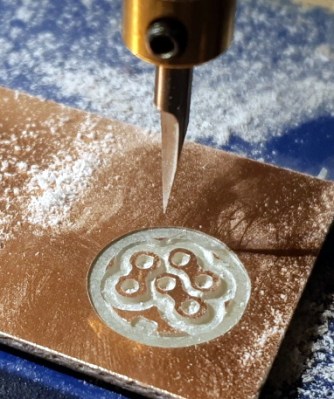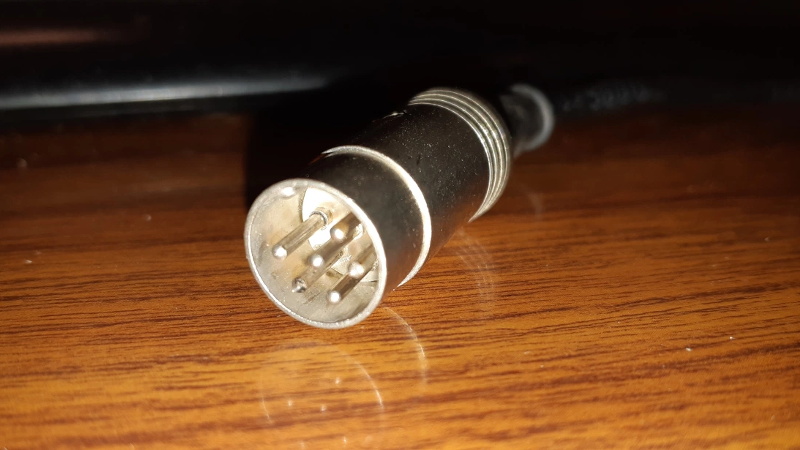When [Charles Ouweland] found himself in need of a DIN connector that had a somewhat unusual pin arrangement, he figured he could fashion his own in less time than it would take to have a replacement shipped to him. In the end it sounds as though it took a lot longer than expected, but given the worldwide situation, we don’t doubt this bespoke connector was still put to work before its eBay counterpart would have arrived.
 More importantly, the connector [Charles] produced looks fantastic. If we weren’t told otherwise, we’d have assumed the finished product was commercially produced. Although to be fair, he did have a little help there. The housing and pins themselves were pulled from a sacrificial connector; his primary contribution was the insulating block that holds the pins in their proper position.
More importantly, the connector [Charles] produced looks fantastic. If we weren’t told otherwise, we’d have assumed the finished product was commercially produced. Although to be fair, he did have a little help there. The housing and pins themselves were pulled from a sacrificial connector; his primary contribution was the insulating block that holds the pins in their proper position.
So how did he make it? He had considered using a piece of scrap material and just putting the holes in it with a drill press, but he was worried getting the aliment right. Instead, he decided to call his cheap CNC router into service. By routing his design out of copper clad PCB, he was even able to tie the appropriate pins together right in the connector.
Admittedly, we don’t see a lot of hardware that still uses DIN connectors these days. But this tip is certainly worth filing away just in case. You never know when you might find an old piece of hardware that just needs a little TLC to get up and running again. Who knows, you might even find a dumpster full of them.

















When I am really in a pinch I put a piece of paper over the mating connector and poke the pre-wired pins through then hot glue them together. Then the dimensions are solid and it has a built in label for future reference.
I did the same thing but I made a cylinder out of masking tape in addition to the paper front and potted the whole thing with epoxy. Looks surprisingly normal if you mix in a little black pigment. Can even embed a little spring around the cable for strain relief.
Whoa! Embedding the spring as a strain relief!
Excellent!
The way I did something like this was to put the wired-up pins in the female side, put a paper gasket (so the glue would not stick), plug in the housing, and pour hot-glue into the housing.
It’s not random at all, it’s a standard 6 pin din connector!
https://en.wikipedia.org/wiki/DIN_connector
I like how there is a [citation needed] for other 6 pin arrangements. If anyone has proof about a different 6 pin din being any sort of standard, good opportunity to contribute to wikipedia
It’s already on wikipedia: https://en.wikipedia.org/wiki/DIN_connector
Could have simply used a 7 pin DIN and left the top pin open…
This is silly
I may be behind but I still recall seeing DIN-5 everywhere in the MIDI context
It’s getting replaced in some contexts by 3.5mm TRS connectors (where the smaller size is a boon) and in others simply by USB-MIDI (where you aren’t expecting it to be used without a computer in the loop somewhere). But you’re right, the DIN-5 probably isn’t going away any time soon. Lots of amazing existing equipment that uses the standard and backwards compatibility is paramount (we wouldn’t be using such an ancient standard with such a low data rate otherwise).
If you *did* want to go the easy way and buy one, Digikey has the plastic backshell variety for $2.16 (https://www.digikey.com/product-detail/en/cui-devices/SD-60/CP-1060-ND/96999), and the metal for a little more.
Yep, that’s the one.
That’s a standard DIN 6 layout of the physical pins, but with 3 “pairs” of signal lines. Very neatly done as well. My guess is for an “oomphy” motor.. like a spindle, NEMA42 servo, etc.. Possibly 5-10A on each “pair”? Either way, an elegant solution.
Thank you. The device draws twice 0.6A at 12V.
Looks like a 270 degries 6pin to me. I like it that he choose to make one himself for the small time gain it gave and of course for the “can I do this?” factor.
This is just DIN, but good luck finding the mating connector when you don’t know the name or type.
I still have the power connector (DIN-6) for my first cassette recorder a Norelco Carrycorder or some such name. The original cassette. About the late 70’s I got a “high end” Pioneer car cassette deck for $100! No it would not fit in your Detroit dash. The matching power amp was another $150. Knowing it had a giant “DIN” connector I bought it. A cassette deck not a radio or clock. I could poke a tape in it knowing what side “a whole album” would play rewound at the beginning without messing with it at all.
Back the DIN thing I didn’t want to void the warranty on the tape deck but I didn’t want to cut off the male pin end of this finger diameter plug.No amp no RCA sockets. So I made a dowel of wood the diameter of the barrel and sanded the end flat and smooth. Then I jammed the plug into the end and had drill points. I had some old ind-mil plugs and sockets and could pull the “pins” out and they mated well with the pins in the stock tape deck. After drilling so to fit the receiving pins into the core of maple wood it all came together in a woodshop level of skill 40 years ago. I still have that jam box I made with it after it came out of mobile use. In the early 80’s it was the ultimate jam box.
Really Lame and Really BORING. To see these so called dumpster diving posts.
In fact it’s an out right lie because there are no electronics dumpstered. Even if broken they won’t throw it away. Big and Small Companies and Small use Goodwill for tax write offs.
Even junk yards have become inventoried and catalogued.
Pick and pulls still exist however you better be comfortable will bringing an entire set of tools that you must watch like a eagle AND guard your wheel barrel of worked components.
Hope you are comfortable will manual hand tools only. No micro torches, no open flame, no power tools. Old style hand drill, large crowbar and a carbide hacksaw blade or two is mandatory.
You litterally must know a friend of a friend of a friend for permission and them on site to be allowed to dumpster dive AND be willing, to do favors, lots and lots of favors. (Hope you own a truck…)
Time is money. You will pay either way.